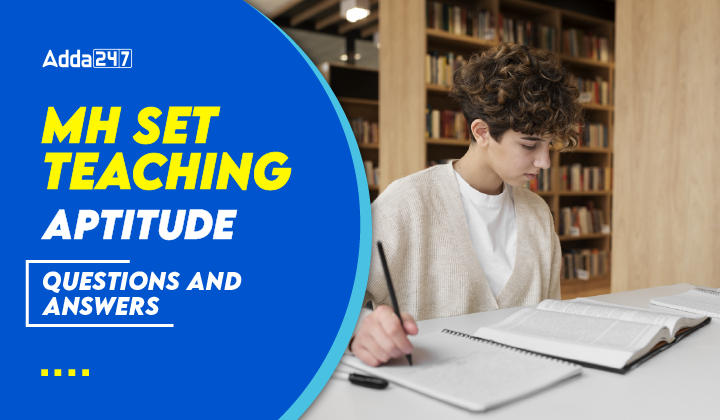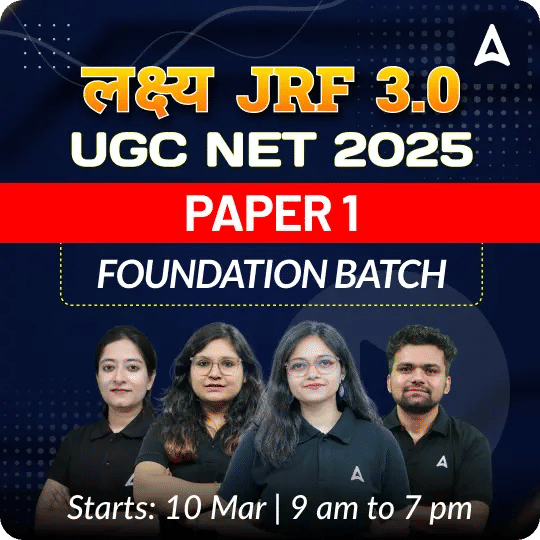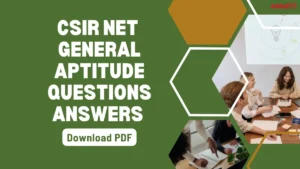Table of Contents
The Maharashtra State Eligibility Test (MH-SET) 2025 is set to take place on 15 June 2025, and candidates should prioritize the Teaching Aptitude section in their preparations. This section, part of Paper-I, assesses essential teaching and research skills important for a career in higher education. Covering key topics required for academic roles, it plays a vital role in determining eligibility. To aid aspirants, we are providing an MH SET Teaching Aptitude MCQs Questions PDF, offering targeted practice to master this critical section effectively.
MH SET Teaching Aptitude
Although the MH SET Teaching Aptitude section is worth only 10 marks, distributed across 5 questions, it plays a essential role in determining your overall score. This section is essential as it assesses your potential as an educator, evaluating your understanding of teaching and learning dynamics. While a thorough grasp of each topic is beneficial, your success primarily depends on developing strong problem-solving skills and applying your knowledge effectively in the context of teaching.
| MH SET Teaching Aptitude | |
| Exam Name | Maharashtra State Eligibility Test (MH-SET) |
| Government | Government of Maharashtra |
| Organized by | Savitribai Phule Pune University, the State Agency |
| MH SET Edition | 40th |
| Post | Assistant Professor |
| Eligibility Test for | Universities and Colleges in the states of Maharashtra & Goa |
| MH SET Subjects | 32 |
| Category | Syllabus and Exam Pattern |
| Type of Questions | Multiple Choice Questions (MCQs) |
| Number of Papers |
|
| Number of Questions | 150 |
| Time Duration | 3 hours |
| Negative Marking | No |
Download MH SET Teaching Aptitude MCQs Questions PDF
Below is the link to access the MH SET Teaching Aptitude MCQs Questions PDF, comprising 50 multiple-choice questions specifically designed to aid candidates in their preparation for the examination. Simply click on the link to download the PDF and bolster your readiness for the MH SET Teaching Aptitude section.
Download MH SET Teaching Aptitude MCQs Questions PDF
MH SET Teaching Aptitude MCQs Questions
Q1. Which of the following statements accurately describes a difference in learning characteristics between adolescents and adults?
(a) Adolescents are inherently less interested in learning than adults
(b) Adolescents require more social stimulation to learn effectively than adults do
(c) Adults are typically more capable of regulating their learning than adolescents are
(d) Adults are more likely to rely on a fixed learning style than adolescents are
Q2. Which of the following teaching methods is not commonly used in higher learning institutions due to its emphasis on rote learning rather than critical thinking and understanding of the subject matter?
(a) Lecturing
(b) Discussion
(c) Memorization
(d) Project-based Learning
Q3. In the Choice-Based Credit System (CBCS) of higher education, which of the following is an appropriate method of evaluation?
(a) Conducting only end-of-semester exams
(b) Assigning projects and assignments throughout the semester
(c) Providing marks based on attendance
(d) Giving students the option to choose their grading scheme
Q4. Which of the following methods are learner-centered teaching methods?
(A) Active learning
(B) Co-operative learning
(C) Inductive teaching and learning
(D) Passive learning
Choose the most appropriate answer from the options given below:
(a) (A), (B), (C) only
(b) (B), (C), (D) only
(c) (A), and, (D) only
(d) (A), (C), (D) only
Q5. The form of asking mainly closed-ended questions that have been used in connection with the examination of people’s normative standards is known:
(a) Abductive technique
(b) Hermeneutics technique
(c) Outlier technique
(d) Vignette technique
Q6. Given below are two statements
Statement I: In a learning organization, the learning of teachers, their professional development, and the learning of children, their education, are inevitably complementary and mutually reinforcing.
Statement II: Intrapersonal intelligence does not involve understanding the inner world of emotions and thoughts, and developing the ability to control and consciously work with them.
In light of the above statements, choose the most appropriate answer from the options given below:
(a) Both Statement I and Statement II are correct
(b) Both Statement I and Statement II are incorrect
(c) Statement I is correct but Statement II is incorrect
(d) Statement I is incorrect but Statement II is correct
Q7. What is the type of graphic organiser or mind tool used for knowledge organisation that can help learners interpret, represent, and organise information by making a graphic in cooperation with others?
(a) concept mapping
(b) divergent question
(c) gestural prompts
(d) hyper media
Q8. What is the meaning of the following expression “learning is product of environment”?
(a) Learning is through the modification and re-modification by the objects and individuals in the environment
(b) Learning is the modification of behaviour
(c) Learning is a process that happens through both physical and mental development of the learner
(d) Learning is a process that happens through experiences
Q9. What is the meaning of adolescent in sociological interpretation?
(a) It represents a young person in transition between the behaviors that are typical of children and the behaviours that are typical of adults
(b) It is a period of identity formation. At this stage, the individual begins to place himself/herself in egospace time.
(c) It is a period in which the individual becomes free from adult constaints.
(d) It is a transitional period between childhood and adulthood when a child moves from dependency upon parents or other adults of the family.
Q10. Which category does this specification belongs to – “Builds a structure or pattern from diverse elements”?
(a) Analysing
(b) Remembering
(c) Creating
(d) Evaluating
Solutions
S1. Ans.(c)
S2. Ans.(c)
S3. Ans.(b)
S4. Ans.(a)
S5. Ans.(d)
S6. Ans.(c)
S7. Ans.(a)
S8. Ans.(a)
S9. Ans.(d)
S10. Ans.(c)
| MH SET Important Links | |
| MH SET 2025 | MH SET Previous Year Question Papers |
| MH SET Teaching Aptitude Questions | MH SET Syllabus |
| MH SET Exam Center List | MH SET Admit card |




 CSIR NET General Aptitude Questions Answ...
CSIR NET General Aptitude Questions Answ...
 UGC NET Research Aptitude Questions with...
UGC NET Research Aptitude Questions with...
 UGC NET 2024-25 Question Papers 1 and 2,...
UGC NET 2024-25 Question Papers 1 and 2,...




